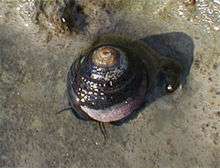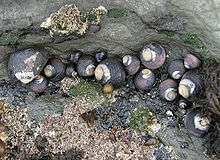Tegula funebralis
| Tegula funebralis | |
|---|---|
 | |
| A live individual of Tegula funebralis in Santa Cruz, California | |
| | |
| Five views of a shell of Tegula funebralis | |
| Scientific classification | |
| Kingdom: | Animalia |
| Phylum: | Mollusca |
| Class: | Gastropoda |
| Clade: | Vetigastropoda |
| Superfamily: | Trochoidea |
| Family: | Tegulidae |
| Genus: | Tegula (gastropod) |
| Species: | T. funebralis |
| Binomial name | |
| Tegula funebralis (A. Adams, 1855) [1] | |
| Synonyms[2] | |
| |
The black turban snail or black tegula, scientific name Tegula funebralis, is a species of medium-sized sea snail with gills and an operculum, a marine gastropod mollusc in the family Tegulidae.[2]
This Eastern Pacific Ocean species was previously known as Chlorostoma funebralis.
Distribution
The species is found off the Pacific coast of North America from Vancouver Island to the central part of the Baja California peninsula in Mexico. It is of the most abundant mollusks of the Californian coast.
Description
Most adult individuals of this species have shells which are 20 to 50 mm (or about an inch, to an inch and three quarters) in diameter.
This species is similar to Tegula gallina in form and characters of the aperture. It is lusterless, purple or black. The apex is usually eroded, and orange-colored. The teeth of the columella are white, and there is never a yellowish streak at the base. The whorls are spirally lirate, sometimes smooth except on the base, sometimes strongly lirate above. The suture is margined below by an impressed line, and by elevated, foliaceous incremental lamellae. This last feature may almost always be detected, although sometimes but very slightly developed. The foliated subsutural margin is characteristic, also, though not always developed.[3]
Empty shells of this species are very often used by hermit crabs, especially Pagurus samuelis.[4]
In 1971, a new sense organ was discovered in this marine snail. Chemoreceptor organs were found near the base on the border of the leaflets of the ctenidium (comb-like respiratory gills), one on each leaflet. They form a light swelling near the base of the leaflet with a pocket lying within the swelling. Together they are termed a "bursicle".[5]
Ecology


Habitat
The species is found in the rocky intertidal zone, where these snails graze on algae, microscopic films, and wrack. Small juveniles are found mostly under rocks and among coarse sands.[6]
Life habits
Tegula funebralis is sexually dimorphic, not hermaphroditic. These snails may live as long as twenty or thirty years.[7]
When fleeing a predator on a sloping substrate, the snail may simply detach itself and thus it will roll or drop away.
Predators
Predators of Tegula funebralis include sea otters, and predatory starfish such as Pisaster ochraceous.[8]
Human use
The black turban snail was harvested in the Early Period by the Native American peoples.[9]
References
- ↑ Adams A., Descriptions of twenty-seven new species of shells from the collection of Hugh Cumming, Esq.; Peoc. Zool. Soc. of London 22 311-317
- 1 2 Bouchet, P. (2012). Tegula funebralis (A. Adams, 1855). Accessed through: World Register of Marine Species at http://www.marinespecies.org/aphia.php?p=taxdetails&id=607163 on 2012-09-10
- ↑ Tryon (1889), Manual of Conchology XI, Academy of Natural Sciences, Philadelphia
- ↑ "Pagurus samuelis – blueband hermit crab". Sanctuary Integrated Monitoring System. National Oceanic and Atmospheric Administration. Retrieved June 20, 2011.
- ↑ Roger Szal (1971). ""New" Sense Organ of Primitive Gastropods". Nature. 229 (5285): 490–492. doi:10.1038/229490a0. PMID 4925208.
- ↑ A.L. Moran. 1997. Spawning and larval development of the black turban snail Tegula funebralis, Journal Marine Biology, Springer/Heidelberg, Volume 128, Number 1, April, 1997, pages 107-114, ISSN 0025-3162
- ↑ Estuary and Coastal Invertebrates
- ↑ Pruitt, Jonathan; Stachowicz, John; Sih, Andrew (February 2012). "Behavioral Types of Predator and Prey Jointly Determine Prey Survival: Potential Implications for the Maintenance of Within-Species Behavioral Variation". the american naturalist. 179 (2): 217–227. doi:10.1086/663680.
- ↑ C. Michael Hogan. 2008. Morro Creek, ed. by A. Burnham.
- Frank, P W (1969), Sexual Dimorphism in Tegula funebralis; the Veliger 11
- Stohler, R (1969), The Type of Tegula funebralis; the Veliger 11
- Turgeon, D.D., et al. 1998. Common and scientific names of aquatic invertebrates of the United States and Canada. American Fisheries Society Special Publication 26 page(s): 61
- McLean J.M. (2007) Gastropoda. In: J. T. Carlton, ed., The Light and Smith Manual: Intertidal invertebrates from central California to Oregon, ed. 4. University of California Press, Los Angeles. Pp. 355–373
External links
| Wikimedia Commons has media related to Tegula funebralis. |